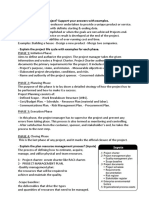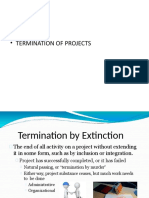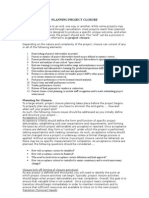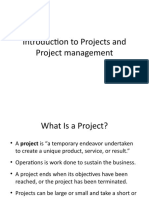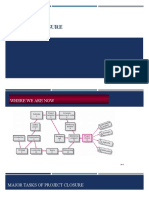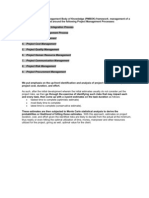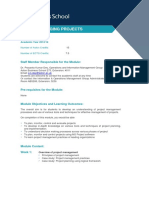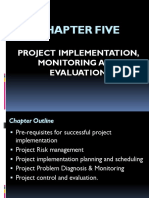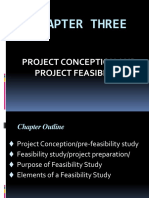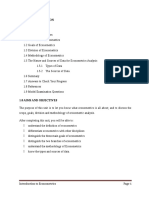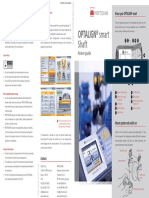0 ratings0% found this document useful (0 votes)
91 viewsChapter Six: Project Termination and Closure
Chapter Six: Project Termination and Closure
Uploaded by
Neway AlemThis document discusses project termination and closure. It describes determining if a project was successful or failed, and capturing lessons learned. There are different approaches to terminating a project, such as extinction, addition, integration, and starvation. The termination process involves deciding whether to terminate and then carrying out that decision. Project closeout involves gaining acceptance of final products/services, archiving records, and lessons learned. The goal is to effectively conclude the project according to requirements and analyze performance.
Copyright:
© All Rights Reserved
Available Formats
Download as PDF, TXT or read online from Scribd
Chapter Six: Project Termination and Closure
Chapter Six: Project Termination and Closure
Uploaded by
Neway Alem0 ratings0% found this document useful (0 votes)
91 views43 pagesThis document discusses project termination and closure. It describes determining if a project was successful or failed, and capturing lessons learned. There are different approaches to terminating a project, such as extinction, addition, integration, and starvation. The termination process involves deciding whether to terminate and then carrying out that decision. Project closeout involves gaining acceptance of final products/services, archiving records, and lessons learned. The goal is to effectively conclude the project according to requirements and analyze performance.
Original Description:
Project
Original Title
P Ch 6
Copyright
© © All Rights Reserved
Available Formats
PDF, TXT or read online from Scribd
Share this document
Did you find this document useful?
Is this content inappropriate?
This document discusses project termination and closure. It describes determining if a project was successful or failed, and capturing lessons learned. There are different approaches to terminating a project, such as extinction, addition, integration, and starvation. The termination process involves deciding whether to terminate and then carrying out that decision. Project closeout involves gaining acceptance of final products/services, archiving records, and lessons learned. The goal is to effectively conclude the project according to requirements and analyze performance.
Copyright:
© All Rights Reserved
Available Formats
Download as PDF, TXT or read online from Scribd
Download as pdf or txt
0 ratings0% found this document useful (0 votes)
91 views43 pagesChapter Six: Project Termination and Closure
Chapter Six: Project Termination and Closure
Uploaded by
Neway AlemThis document discusses project termination and closure. It describes determining if a project was successful or failed, and capturing lessons learned. There are different approaches to terminating a project, such as extinction, addition, integration, and starvation. The termination process involves deciding whether to terminate and then carrying out that decision. Project closeout involves gaining acceptance of final products/services, archiving records, and lessons learned. The goal is to effectively conclude the project according to requirements and analyze performance.
Copyright:
© All Rights Reserved
Available Formats
Download as PDF, TXT or read online from Scribd
Download as pdf or txt
You are on page 1of 43
CHAPTER SIX
PROJECT TERMINATION AND
CLOSURE
Chapter Outline
Project Learning: Success/Failure
Determination
Project Termination and its approaches
Project closeout
Tasks of project closure
Project Learning: Success/Failure Determination
The lessons-learned document captures the
successes, challenges, and other information of a
project.
Similar projects in the future can refer to what is
in the document and, consequently, operate
more efficiently and effectively.
The lessons-learned document helps to identify
their own strengths and weaknesses.
Project success criteria are the standards by
which the project will be judged at the end to
decide whether or not it has been successful in
the eyes of the stakeholders.
Project Learning: Success/Failure Determination
Lessons Learned Database
Categorized electronic project information
database
Continuous Improvement Recommendations
Project Management Process
Forms
Standards
Project Learning: Success/Failure Determination
Sample questions:
What happened on the project that surprised you?
What do you know now about the project that you wish you had
known earlier? How would this have changed the project?
What skills or knowledge turned out to be the most important?
How effectively did the team capture and communicate the voice
of the customer?
How effective were the project’s quality control and assurance
activities?
What is your level of comfort with regard to the product’s quality?
To what extent was the project life cycle that was used an
effective means of driving the project and generating its
deliverables?
Project Learning: Success/Failure Determination
Evaluating Project Success
Project purpose
Deliverables
Measurable success indicators
Quality
Schedule
Cost
Schedule
Is there a hard deadline, or does the schedule relate
to something else (budget, product launch date, etc.)?
In the end, did you complete the project by the time
it was due?
Project Learning: Success/Failure Determination
Sometimes clients come with a hard deadline, other
times they’re simply looking for the final product.
Scope
A list of features or just an idea, but the scope should
essentially be the driving force of the project
What do you need to get done within the timeframe?
Budget
In the end, did you stick to the budget?
Your team should always know where they stand in
terms of money spent.
Project Learning: Success/Failure Determination
Team satisfaction
This is one that often goes overlooked in project
management. work shouldn't feel only like an
obligation.
Customer satisfaction
Often figure out what the customer looking for in
order to make sure they’re happy with the end
product.
How do you track client satisfaction? Ask them to
rate it on a scale of 1 to 10 every week or so, and
analyze and review your findings.
Project Learning: Success/Failure Determination
Quality of work
If you deliver a strong product, your client will
tell people about it, and that's where your next
project should come from.
Planning for project termination includes
Transferring responsibility
Completion of project records
Historic reports
Post-project analysis
Documenting results to reflect “as built” product or
installation
Acceptance by sponsor/user
Satisfying contractual requirements
Releasing resources
Reassignment of project office team members
Disposition of functional personnel
Disposition of materials
Closing out work orders (financial closeout)
Preparing for financial payments
Project Termination and its approaches
A project can be said to be terminated when
work on the substance of the project has ceased
or slowed to the point that further progress is no
longer possible
There are four fundamentally different ways to
close out a project: extinction, addition,
integration, and starvation
Termination by Extinction
The project may end because it has been
successful and achieved its goals
The project may also be stopped because it is
unsuccessful or has been superseded
A special case of termination by extinction is
“termination by murder” which can range from
political assassination to accidental projecticide
Two important characteristics of termination by
murder are the suddenness of project demise
and the lack of obvious signals that death is
imminent
Termination by Extinction
When a decision is made to terminate a project
by extinction, the most noticeable event is that all
activity on the substance of the project ceases
Termination by Addition
If a project is a major success, it may be
terminated by institutionalizing it as a formal part
of the parent organization
Project personnel, property, and equipment are
often simply transferred from the dying project to
the newly born division
The transition from project to division demands a
superior level of political sensitivity for successful
accomplishment
Termination by Integration
This method of terminating projects is the most
common way of dealing with successful projects,
and the most complex
The property, equipment, material, personnel, and
functions of the project are distributed among
the existing elements of the parent organization
Termination by Integration
In general, the problems of integration are
inversely related to the level of experience that
the parent or client has had with:
the technology being integrated
the successful integration of other projects, regardless
of technology
Termination by Integration
A few of the more important aspects of the
transition from project to integrated operation
that must be considered:
Personnel - where will the team go?
Manufacturing - is the training complete?
Accounting/Finance - have the project’s account
been closed and audited?
Engineering - are all drawings complete and on file?
Information Systems/Software - has the new
system been thoroughly tested?
Marketing - is the sales department aware of the
change?
Termination by Starvation
This type of project termination is a “slow
starvation by budget decrement”
There are many reasons why senior management
does not wish to terminate an unsuccessful or
obsolete project:
Politically dangerous to admit that one has
championed a failure
Terminating a project that has not accomplished its
goals is an admission of failure
Bad manners to enquire the status of the project
When to Terminate a Project
Some questions to ask when considering
termination:
Has the project been obviated by technical advances?
Is the output of the project still cost-effective?
Is it time to integrate or add the project as a part of
regular operations?
Are there better alternative uses for the funds, time
and personnel devoted to the project?
Has a change in the environment altered the need for
the project’s output?
When to Terminate a Project
Fundamental reasons why some projects fail to
produce satisfactory answers to termination
questions:
A project organization is not required
Insufficient support from senior management
Naming the wrong person as project manager
Poor planning
These and a few other reasons, are the base
cause of most project failures
The specific causes derive from these
fundamental issues
The Termination Process
The termination process has two distinct parts
First is the decision whether or not to terminate
Second, if the decision is to terminate the project,
the decision must be carried out
The Decision Process
Decision-aiding models for the termination
decision fall into two generic categories:
Models that base the decision on the degree to which
the project qualifies against a set of factors generally
held to be associated with successful projects
Models that base the decision on the degree to which
the project meets the goals and objectives set for it
Just as the decision criteria, constraints, weights,
and environmental data are unique to each
organization, so are the specifics of using any
decision model
Project Closeout
Involves gaining stakeholder and customer
acceptance of the final products and services.
Even if projects are not completed, they should be
formally closed in order to reflect on what can be
learned to improve future projects.
Outputs include project archives and lessons
learned , which are part of organizational process
assets
Most projects also include a final report and
presentation to the sponsor or senior
management
Project Closeout
Closing out follow particular disciplines and
procedures with the objective of:
Effectively bringing the project to closure according to
agreed-on contractual requirements
Preparing for the transition of the project into the next
operational phase, such as from production to field
installation, field operation, or training
Analyzing overall project performance with regard to
financial data, schedules, and technical efforts
Closing the project office, and transferring or selling off
all resources originally assigned to the project, including
personnel
Identifying and pursuing follow-on business
Project Closeout
The project closing is the last phase of all project
processes.
The closing process consists of two sub-
processes:
Contract closeout
Administrative closure
Obtain formal acceptance of the product of the
project from stakeholders & customers.
The goal of closing is to get an official sign-off
from the stakeholders acknowledging acceptance
of the product and to file this with the project
documents.
Project Closeout
After delivering a successful project to the customers
& stakeholders the project must come to an end.
For this the successful end has to be defined
1. Normal: The most common circumstance for
project closure is simply a completed project.
2. Premature: For a few projects, the project may be
completed early with some parts of the project
eliminated.
3. Perpetual: Some projects never seem to end. The
major characteristic of this kind of project is
constant “add-ons,” suggesting a poorly conceived
project scope.
Project Closeout
4. Failed Project: Failed projects are usually easy to
identify and easy for a review group to close down.
However, every effort should be made to
communicate the technical (or other) reasons for
termination of the project;
5. Changed Priority: Organizations’ priorities often
change and strategy shifts directions. Projects in
process may need to be altered or canceled.
On completion, the site must be cleared, all
temporary buildings, structures and fences have to
be removed, and access roads made good.
Contract Administration
Summarize project contract closure activities such as
formally closing all contracts associated with the
completed project
Aware of the legal implications of actions taken when
administering the contract
Application of the appropriate project management
processes to the contractual relationship(s) and
integration of the outputs from these processes into the
overall management of the project
Administrative closure
Following activities must be address in the
project closure plan:
Identifying tasks necessary to close the project
Assigning individuals to carry out closure tasks
Monitoring implementation
Ending closure process
Administrative closure
Important tasks:
Project accounts closure:
Outside vendors
Partners
Information system professionals
Temporary workers
Outside vendors and professionals should be
evaluated for:
Responsiveness
Reliability
Service quality
Adherence to contract terms
Administrative closure
Obtaining delivery acceptance from the customer
Stops scope creep
Confirms delivery date and the end of the project
Equipment and facility release
Avoids inaccurate accounting
Helps proper use of organizational resources
Project personnel release
Sometimes, team members develop psychological
link with the project and want to continue
indefinitely
Administrative closure
Acknowledgements and awards
Acknowledge and reward individuals,
departments and centers that influenced the
project success
Organizing a social event is appropriate to
hand out awards and announce the project
closure
Sometimes, organizations use such events
to launch new services or systems that
benefits customers and employees
Tasks of project closure
When a project is moving toward its natural
conclusion, a number of activities are necessary to
close it out.
The process of closing out a project is complex,
involving multiple activities that must occur across
a defined period.
Tasks of project closure
Finishing the Work
A number of tasks still need to be completed or
polished, such as a final debug on a software package.
People working on the project naturally tend to lose
focus - to begin thinking of new project assignments or
their pending release from the team.
The challenge for the project manager is to keep the
team zeroed in on the final activities, particularly as the
main elements of the project dramatically wind down.
An orderly process for completing final assignments
usually requires the use of a checklist as a control
device.
Tasks of project closure
Handing over the project
Transferring the project to its intended user usually
involves a formal transfer of ownership of the project
to the customer, including any terms and conditions for
the transfer.
Transfer does not just involve shifting ownership; it also
requires establishing training programs for users,
transferring and sharing technical designs and features,
making all drawings and engineering specifications
available, and so on.
Depending on the complexity of the transfer process,
the handing-over steps can require meticulous planning
in their own right.
Tasks of project closure
Handing over the project
Now it is common to refuse initial acceptance of a
project by customers until after a transition period in
which the project contractor must first demonstrate
the viability of the project.
Build, operate, and transfer (Bot)
Build, own, operate, and transfer (Boot) - A
modification on BOT alternative
Although they serve to protect the client, they
expose the contractor to serious potential damages
in the event of project failure
Tasks of project closure
Gaining acceptance for the project
“Client acceptance” represents the recognition that
simply transferring the project to the customer is not
sufficient to ensure the customer’s happiness with it,
use of it, and recognition of its benefits.
Some customers will purposely withhold unconditional
acceptance of a project because they fear that after
granting it, they will lose the ability to ask for
modifications or corrections for obvious errors.
When we start planning for the project’s development,
we need to also start planning for the project’s transfer
and use to ease the client’s transition to ownership.
Tasks of project closure
Harvesting the Benefits
Projects are initiated to solve problems, capitalize on
opportunities, or serve some specific goal(s).
The idea of harvesting project benefits suggests that
we be in a position to assess the value the project adds,
either to an external customer or to our own firm, or
both.
Benefits come in many forms and relate to the project
being created.
The bottom line for harvesting the benefits suggests
that the project organization should begin to realize a
positive outcome from the completion of the project
Tasks of project closure
Harvesting the Benefits
It may be difficult to accurately assess the benefits from
a project, particularly in the short run.
Develop an effective and meaningful measurement
system that identifies the goals, time frame, and
responsibilities involved in project use and value
assessment worked out in advance
Tasks of project closure
Reviewing how it all Went
Some basic principles must be followed when
evaluating a project’s (and project team’s) performance.
Post-project reviews strive to be as objective as
possible, and in many organizations project reviews are
conducted by using outsiders.
Four principles cover proper post-project reviews:
Objectivity - the need for an unbiased, critical
review of the project from the perspective of
someone without an agenda
Internal consistency - A logical and well-
constructed procedure must be established and
followed when conducting reviews
Tasks of project closure
Reviewing how it all Went
Replicability - A standardized review process
should yield similar findings regardless of who
conducts the evaluation
Fairness - Members of the project team must
perceive that the review was conducted fairly,
without agendas, and intended to highlight both
successes and failures.
Chapter End
Course End
You might also like
- Most Important Topics-CISA Review Manual (27th Edition)Document8 pagesMost Important Topics-CISA Review Manual (27th Edition)Vrushank BhattNo ratings yet
- Script FreebitcoinDocument13 pagesScript Freebitcoinmuazzam naseer50% (32)
- 2.1.6.validate Scope TemplatesDocument2 pages2.1.6.validate Scope TemplatesAssad AssadNo ratings yet
- Unit 4 IpDocument7 pagesUnit 4 IpJohannah MunozNo ratings yet
- Project ClosureDocument16 pagesProject Closuresohaib900009No ratings yet
- Chapter 9 Project Resource ManagementDocument25 pagesChapter 9 Project Resource ManagementNilbertNo ratings yet
- Lecture 1 Introduction AND Project Initiation and DefinitionDocument18 pagesLecture 1 Introduction AND Project Initiation and DefinitionJuliet KabahendaNo ratings yet
- Section I: The Project Management Framework: Dr. Saif UllahDocument76 pagesSection I: The Project Management Framework: Dr. Saif UllahTalhaMahmoodNo ratings yet
- MODULE 4 Project-Quality-Management1Document52 pagesMODULE 4 Project-Quality-Management1Tewodros TadesseNo ratings yet
- Project Management Techniques: Prof. (DR.) T. Muthukumar M.SC M.C.A M.B.A M.Phil PH.DDocument65 pagesProject Management Techniques: Prof. (DR.) T. Muthukumar M.SC M.C.A M.B.A M.Phil PH.DDinesh KumarNo ratings yet
- Change Management in Project ManagementDocument8 pagesChange Management in Project ManagementPuneetNo ratings yet
- Introduction To Project ManagementDocument51 pagesIntroduction To Project ManagementMuhammad FaisalNo ratings yet
- PM CHP 04Document44 pagesPM CHP 04Abbas SkyNo ratings yet
- Chapter 5 ScopeDocument12 pagesChapter 5 ScopeEnas SalahatNo ratings yet
- Project ManagementDocument51 pagesProject ManagementMustafa Dursun100% (1)
- Effective Leadership in Project Management Demands On and Profile of Leaders ProgressDocument14 pagesEffective Leadership in Project Management Demands On and Profile of Leaders ProgressMark Joseph Aguado SoreNo ratings yet
- Chapter 11-ProjectControlDocument42 pagesChapter 11-ProjectControlJeng AndradeNo ratings yet
- Unit 1Document27 pagesUnit 1Renish RanganiNo ratings yet
- Project Q Exam AnswersDocument8 pagesProject Q Exam AnswersAmir H. Al-ShurafaNo ratings yet
- Session 1 - Week 1 - Introduction To Project ManagementDocument27 pagesSession 1 - Week 1 - Introduction To Project ManagementXinran LiuNo ratings yet
- Project TerminationDocument13 pagesProject TerminationsakshiNo ratings yet
- Planning Project ClosureDocument3 pagesPlanning Project Closurefakhro100% (2)
- Project Closure Chapter OutlineDocument10 pagesProject Closure Chapter OutlineBasit KhanNo ratings yet
- LO3 - Operations and Project Management LO3Document49 pagesLO3 - Operations and Project Management LO3Diana Elena ChiribasaNo ratings yet
- Week 12 - Project Procurement ManagementDocument32 pagesWeek 12 - Project Procurement ManagementSơn Tùng Nguyễn Khương100% (2)
- Chapter 2. Complex Project ManagementDocument55 pagesChapter 2. Complex Project ManagementSeyfe MesayNo ratings yet
- Project TerminationDocument16 pagesProject TerminationazsrxNo ratings yet
- BSBPMG540 Assessment 1Document6 pagesBSBPMG540 Assessment 1zenny2661No ratings yet
- Minor ProjectDocument51 pagesMinor ProjectShekhar KumarNo ratings yet
- Assignment 3Document3 pagesAssignment 3Shahzad MughalNo ratings yet
- Mbad 782 Project Management NotesDocument75 pagesMbad 782 Project Management NotesKevin ManyaraNo ratings yet
- Project Stakeholder ManagementDocument48 pagesProject Stakeholder ManagementRoza ainun tasyaNo ratings yet
- Third Quiz of MGt503 16-12-2011Document10 pagesThird Quiz of MGt503 16-12-2011AliImranNo ratings yet
- Project Management L5 Assessment Brief May 2021Document8 pagesProject Management L5 Assessment Brief May 2021JisanNo ratings yet
- Chapter 1 - Modern Project Management: E) - Specific Time, Cost, and Performance RequirementsDocument52 pagesChapter 1 - Modern Project Management: E) - Specific Time, Cost, and Performance RequirementsKhathutshelo KharivheNo ratings yet
- CAMP-Exam-Prep-Updated-for-2023 1Document17 pagesCAMP-Exam-Prep-Updated-for-2023 1Jay VNo ratings yet
- Project Communications ManagementDocument8 pagesProject Communications Managementillezia100% (1)
- Planning: "Planning Is Deciding in Advance What To Do, How To Do It, When To Doitandwhoistodoit"Document22 pagesPlanning: "Planning Is Deciding in Advance What To Do, How To Do It, When To Doitandwhoistodoit"Tijo ThomasNo ratings yet
- Project Management FundamentalsDocument4 pagesProject Management FundamentalsRamakant BhardwajNo ratings yet
- Project Scope ManagementDocument53 pagesProject Scope ManagementmohammednatiqNo ratings yet
- Project Management Tools and TechniquesDocument32 pagesProject Management Tools and TechniquesTariq Bezinjo100% (1)
- PM TextDocument35 pagesPM Textpassword123reset100% (2)
- Project Communication ManagementDocument66 pagesProject Communication ManagementAlaa100% (1)
- PM Introduction Chapter 1Document45 pagesPM Introduction Chapter 1bharathi.g.shan3743No ratings yet
- PM Chapter 04 Project Management ProcessesDocument85 pagesPM Chapter 04 Project Management ProcessesfahadneoNo ratings yet
- Project ClosureDocument17 pagesProject ClosureTakarial lNo ratings yet
- Assignment Project Management INDIVIDUALDocument21 pagesAssignment Project Management INDIVIDUALshewameneBegashawNo ratings yet
- Project and Program ManagementDocument3 pagesProject and Program ManagementAbner A Arrieta JrNo ratings yet
- PMBOK Chapter 2-3 Project Environment and PM RoleDocument19 pagesPMBOK Chapter 2-3 Project Environment and PM RolePMS BDNo ratings yet
- Introduction To Project ManagementDocument33 pagesIntroduction To Project ManagementMD IMRAN HOSSAINNo ratings yet
- Project Risk Management HanbookDocument8 pagesProject Risk Management HanbookSamuel MarioghaeNo ratings yet
- Chapter 12 Project Procurement ManagementDocument37 pagesChapter 12 Project Procurement ManagementFederico KeselmanNo ratings yet
- 02 Project Management Glossary of Terms - PDF (PMP LEXICON)Document32 pages02 Project Management Glossary of Terms - PDF (PMP LEXICON)sreyantiNo ratings yet
- CHAPTER 2 - Lifecycle of A Project ManagementDocument35 pagesCHAPTER 2 - Lifecycle of A Project ManagementhalinaNo ratings yet
- PMP QuestionnaireDocument31 pagesPMP QuestionnaireHossam Nour100% (2)
- PMBOK QUIZ 6 - Quality 2019Document8 pagesPMBOK QUIZ 6 - Quality 2019CarlosNo ratings yet
- Bnm808 Managing Projects: Staff Member Responsible For The ModuleDocument5 pagesBnm808 Managing Projects: Staff Member Responsible For The ModulechockalingamNo ratings yet
- PMBOK Chapter 11 - ProcurementDocument39 pagesPMBOK Chapter 11 - Procurementlatehours100% (1)
- Project Selection and PrioritizationDocument52 pagesProject Selection and PrioritizationRohonNo ratings yet
- Nuts and Bolts of Project Management: Right Timing + Right Decision = SuccessFrom EverandNuts and Bolts of Project Management: Right Timing + Right Decision = SuccessRating: 5 out of 5 stars5/5 (1)
- Chapter One - Information Processing and ManagementDocument112 pagesChapter One - Information Processing and ManagementNeway AlemNo ratings yet
- Chapter 6 Compensation ManagementDocument45 pagesChapter 6 Compensation ManagementNeway AlemNo ratings yet
- CHAPTER FIVE- Information Technology for Decision MakingDocument41 pagesCHAPTER FIVE- Information Technology for Decision MakingNeway AlemNo ratings yet
- Chapter Five: Project Implementation, Monitoring and EvaluationDocument84 pagesChapter Five: Project Implementation, Monitoring and EvaluationNeway Alem100% (2)
- Chapter 5 performance ApprasalDocument56 pagesChapter 5 performance ApprasalNeway AlemNo ratings yet
- Qualitative ResearchDocument87 pagesQualitative ResearchNeway AlemNo ratings yet
- Chapter Five Quality Management and Control: Complied by Asmamaw T. (PHD)Document57 pagesChapter Five Quality Management and Control: Complied by Asmamaw T. (PHD)Neway AlemNo ratings yet
- Chapter Three: Project Conception and Project FeasibilityDocument29 pagesChapter Three: Project Conception and Project FeasibilityNeway AlemNo ratings yet
- CollinarityDocument6 pagesCollinarityNeway AlemNo ratings yet
- Chapter Two: Project Life CycleDocument54 pagesChapter Two: Project Life CycleNeway Alem100% (4)
- Econometrics Chapter 1 7 2d AgEc 1Document89 pagesEconometrics Chapter 1 7 2d AgEc 1Neway AlemNo ratings yet
- Econometrics Module 2Document185 pagesEconometrics Module 2Neway Alem100% (1)
- Financial and Managerial Acct-5Document75 pagesFinancial and Managerial Acct-5Neway AlemNo ratings yet
- Applied Econometrics Lecture 1: IntroductionDocument34 pagesApplied Econometrics Lecture 1: IntroductionNeway AlemNo ratings yet
- Chapter 4Document55 pagesChapter 4Neway AlemNo ratings yet
- Applied Econometrics ModuleDocument142 pagesApplied Econometrics ModuleNeway Alem100% (1)
- Chapter 1Document18 pagesChapter 1Neway AlemNo ratings yet
- Financial and Managerial Acct - 1Document49 pagesFinancial and Managerial Acct - 1Neway AlemNo ratings yet
- GUI LPC2103 Cau Trúc Phàn C NGDocument104 pagesGUI LPC2103 Cau Trúc Phàn C NGBắc HoàiNo ratings yet
- Citrix Internals: ICA Connectivity: Denis Gundarev, Senior Consultant, Entisys Solutions May 21, 2014Document52 pagesCitrix Internals: ICA Connectivity: Denis Gundarev, Senior Consultant, Entisys Solutions May 21, 2014mosqiNo ratings yet
- Link - MASM TOUR To MASM MTN - Proposal - ReportDocument5 pagesLink - MASM TOUR To MASM MTN - Proposal - ReportAdos AgbidinoukounNo ratings yet
- Lab 02Document24 pagesLab 02aimenzahid600100% (1)
- Tutorial Flow SimulationDocument322 pagesTutorial Flow SimulationJuliano André Petry100% (1)
- XPrinter V3.0CDocument9 pagesXPrinter V3.0CAgui Esc Gisse0% (1)
- Huawei Training & CertificationDocument5 pagesHuawei Training & CertificationZeramNo ratings yet
- M-Turbo Brochure v14Document6 pagesM-Turbo Brochure v14Andrea ReyesNo ratings yet
- Gssi Sir 3000brochureDocument4 pagesGssi Sir 3000brochurel0k0tus100% (1)
- Fog 40 PagesDocument40 pagesFog 40 PagesMandara ManjunathNo ratings yet
- Brief Calculus With Integrated Precalculus by Joseph CollisonDocument352 pagesBrief Calculus With Integrated Precalculus by Joseph CollisonrandonamNo ratings yet
- An Anti-Jamming Technique by Jammer Localization For Multi-Channel Wireless Sensor NetworksDocument21 pagesAn Anti-Jamming Technique by Jammer Localization For Multi-Channel Wireless Sensor Networksijcncjournal019No ratings yet
- Project ReportDocument10 pagesProject ReportchaitanyaNo ratings yet
- Extension Board PDFDocument7 pagesExtension Board PDFVector MatrizNo ratings yet
- Microprocessor Instruction Set of Intel 8085Document9 pagesMicroprocessor Instruction Set of Intel 8085Sreejith UnnikrishnanNo ratings yet
- English For Travelling - Poziom B2Document13 pagesEnglish For Travelling - Poziom B2Ирина МосиенкоNo ratings yet
- OPTALIGN Smart Pocket Guide PDFDocument2 pagesOPTALIGN Smart Pocket Guide PDFMahmoud MohamedNo ratings yet
- Business Intelligence and Data Warehousing (09.07.2020)Document14 pagesBusiness Intelligence and Data Warehousing (09.07.2020)Emmanuel MasindikeNo ratings yet
- CatOS Vs IOSDocument9 pagesCatOS Vs IOSprojectkmoNo ratings yet
- Computer Science Old: 1. Data Structures & Programming MethodologiesDocument5 pagesComputer Science Old: 1. Data Structures & Programming MethodologiesAneesh KurianNo ratings yet
- Chap 13 PDFDocument33 pagesChap 13 PDFNaima KhanNo ratings yet
- PYCS 06 - Repeating Things - ColaboratoryDocument6 pagesPYCS 06 - Repeating Things - Colaboratorygodspower brunoNo ratings yet
- MAD MicroprojectDocument27 pagesMAD MicroprojectMayur CO 17No ratings yet
- Red Hat Virtualization-4.3-Installing Red Hat Virtualization As A Standalone Manager With Local databases-en-USDocument72 pagesRed Hat Virtualization-4.3-Installing Red Hat Virtualization As A Standalone Manager With Local databases-en-USMadavan RajNo ratings yet
- HP Elite x360 1040 G9 DatasheetDocument43 pagesHP Elite x360 1040 G9 DatasheetJuan Dela CruzNo ratings yet
- BloombergDocument36 pagesBloombergNurul Annisa100% (2)
- Control of Vapor Recovery Units (VRU)Document8 pagesControl of Vapor Recovery Units (VRU)Yasmine ياسمينNo ratings yet
- Computational Mechanics With Deep Learning: Genki Yagawa Atsuya OishiDocument408 pagesComputational Mechanics With Deep Learning: Genki Yagawa Atsuya Oishichristian wendt100% (1)


















